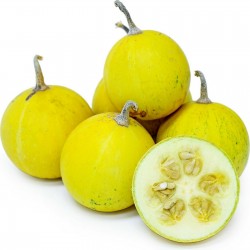
Coming Soon









Cucurbita foetidissima is a tuberous xerophytic plant found in the central and southwestern United States and northern Mexico. It has numerous common names, including buffalo gourd, calabazilla, chilicote, coyote gourd, fetid gourd, fetid wild pumpkin, Missouri gourd, prairie gourd, stinking gourd, wild gourd, and wild pumpkin. The type specimen was collected from Mexico by Humboldt and Bonpland sometime before 1817.
The feral perennial buffalo gourd has evolved in the semiarid regions and is well-adapted to desert environments. It contains high amounts of protein and carbohydrates and yields abundant oil. The carbohydrates that are formed in the taproot have led to the idea of growing the plant for biofuel.
The fruit is consumed by both humans and animals. When mature, a stage marked by increasing desiccation of vine, leaves, fruit-stem, and fruit, the fruit begins its final gourd stage.
Geographic location and genetics make it highly likely that Cucurbita scabridifolia originated as a naturally occurring hybrid of C. foetidissima and Cucurbita pedatifolia.
Morphology and cultivation
Cucurbita foetidissima requires little water and grows best in semiarid and arid environments.[9] Warm weather is required during the five- to eight-month vegetation period.[5][10] This perennial is well adapted to marginal agricultural lands such as sandy loam soils which have to be well-drained. Germination temperature range is between 15 °C and 37 °C with an optimum at 25 °C.
The maximum depth for a successful germination is 12 cm. The germination is possible in a pH range from 2.2 (germination rate 15% ) up to pH 8 (germination rate 90%). Asexual propagation is possible from nodal roots.
The leaves of the buffalo gourd are typically entire and heart-shaped with a base of 10–13 cm (4–5 in) and length of 20–25 cm (8–10 in). The flowers are borne singly at the nodes of the vines after a certain amount of annual vegetative growth has taken place.
The fruit has a diameter of 7–10 cm (3–4 in). The fruit weighs 120 g to 150 g, with 292 to 315 seeds per fruit. The seeds, which are 12 mm (0.5 in) long and 7 mm (0.3 in) wide, weigh about 4 g per 100 seeds, with the seed coat accounting for about 30% of the seed weight. The seeds often remain viable for months or even years within an undamaged gourd. One hectare of plants can produce 2.5 tons of seed.
The plant forms a fleshy taproot which is used as a storage and overwintering structure. The central taproot can weigh up to 72 kg (159 lb). A four-year-old root grown under cultivation can reach a fresh weight of 45 kg (99 lb) and a length of 2.5 m (8.2 ft).
Distribution
Cucurbita foetidissima is native to North America in the central and southwestern United States (Arizona; Arkansas; southern California; Colorado; Kansas; Missouri; southern Nebraska; southern Nevada, New Mexico; Oklahoma; Texas; and southern Utah) and Mexico (Aguascalientes; Chihuahua; Coahuila; Guanajuato; Guerrero; Hidalgo; northern Jalisco; Mexico; Nuevo León; Querétaro; San Luis Potosí; Sonora; Tamaulipas; and Zacatecas).
Uses
The buffalo gourd has the potential of being a crop adapted to arid to semiarid lands.
Fresh gourd: The fresh young gourd can be eaten like squash. The mature fruit is no longer edible, due to bitter compounds.
Seeds: Eaten after being prepared by roasting or boiling.
Oil: The extractable oil content in whole seeds reaches from 24.3% to 50%. Linoleic acid, an essential polyunsaturated fatty acid, comprises 38% to 65% of the oil. Characterization of the oils from buffalo gourd indicates that this oil is similar to other common edible oils.
Protein: Whole Buffalo gourd seeds contain approximately 31% crude protein, which is usable for human consumption and for feed.
Starch: Is mainly located in the taproot which forms after the first year of growth. The starch content in the dried root is between 47.5%[11] and 56%.
Fodder: Fresh leaves or the whole plants can be used as animal food.
Biofuel: Biodiesel can be produced from the oil in the seeds.[17] But the main interest to produce renewable fuels is to produce biofuel with the carbohydrates which are located in the tap root.
Other uses: In many Native American cultures, the fruit and other parts of the plant, buffalo gourd oil, were used for soap.[18] Furthermore, the protein can be used for industrial purposes (water paints, paper coating, adhesives, and textile sizing).
The Zuni people use a poultice of powdered seeds, flowers, and saliva for swellings
Data sheet

 Reviews (0)
Reviews (0)